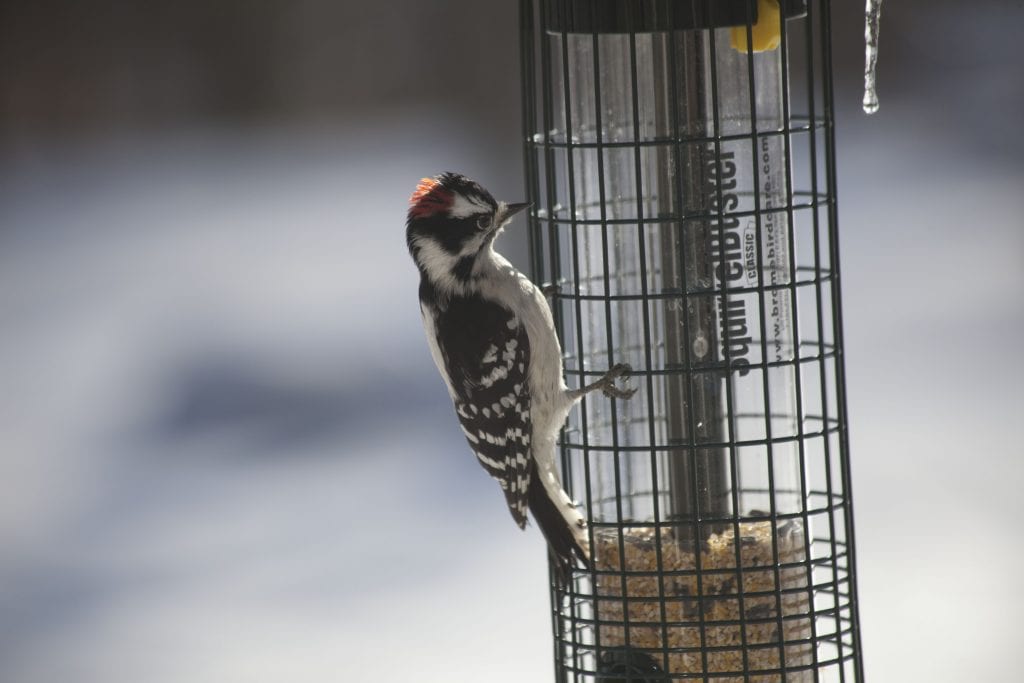
Maine Audubon’s mission is to conserve Maine’s wildlife and wildlife habitat by engaging people in education, conservation, and action. Today, that mission seems more important than ever. Our educators, scientists, advocates, and naturalists are committed to keeping you connected to the natural world as we deal with the coronavirus situation together. Check in every weekday on our Connections page for family activities, parent/teacher tips, backyard birding, nature exploration at our sanctuaries, and live events.
Not all birdseeds are created the same, and a little knowledge of what you’re putting in your feeders can help you attract the birds you want, and lots of them.
Let’s start with some basics. Not all birds eat seeds. In fact, most of them don’t–they prefer insects or fruit. But there aren’t a lot of insects to be had during a Maine winter (unless you’re a woodpecker prying them out from hideouts in tree bark), and so many of the birds that spend the winter here will visit your feeders.
In the spring and summer there are more things around for birds to eat, though seed-eating birds will still come to your feeder. However, when birds have babies to feed, almost every single bird species we have, including species that otherwise only eat seeds, needs one thing: caterpillars. These little crawlers are a perfect food for growing baby birds, and a single brood of chicks eats thousands of caterpillars before it leaves the nest.
So, caterpillars are super-important, but how do you get them? Plant native plants. Native caterpillars of moths and butterflies need native plants to feed on and grow, and can’t just switch to some plant they’re not used to. Planting native plants is the best way to get native caterpillars and to feed native birds. Visit Maine Audubon’s Bringing Nature Home page to learn more about what native plants to put in your garden, and where to find them.
But back to seeds.
The backyard birder should know that different birds eat different kinds of seed, and attracting the birds you want depends on what you offer them. It’s important to read the ingredients. It makes sense if you think about it: in the same way that you read the ingredients on a package of food you’re about to eat, you should understand what you’re feeding your birds. The marketing on the front of the package isn’t always honest. Here are some of the more popular seed choices.
Black Oil Sunflower
This is probably the most popular seed, and with good reason: it attracts the most birds. Black Oil Sunflower seeds are basically the same things that baseball players snack on (please do not eat your birdseed): the black triangular shell with the meaty seed inside. This is a large, nutritious seed that is eaten by many birds, everything from Northern Cardinals to chickadees to finches to sparrows to Blue Jays to even woodpeckers. It’s even sold in a pre-shelled version, which makes it easier for birds to eat and makes less of a mess underneath your feeders.
Cracked Corn
Cracked corn is dried corn kernels that are broken up, making them easier to eat. This is a tougher product, and so is eaten by larger birds with stronger bills. Cracked corn will bring Blue Jays, Red-winged Blackbirds, Eastern Towhees, and Dark-eyed Juncos.
Thistle
Also sometimes marketed as nyjer, thistle is a much smaller, finer seed, and so is appropriately eaten by smaller birds with smaller bills. Thistle is beloved by finches, especially the smaller ones like American Goldfinch, Common Redpoll, and Pine Siskin. Thistle is light, and can blow away easily if placed into a normal feeder. Look for it sold in “socks,” refillable mesh-type containers that allow birds to pull the seeds out, or in other smaller feeders.
Millet
There are two types of millet: red and white. This round seed is a favorite of birds that spend time on the ground, like Mourning Doves, sparrows, Brown Thrashers, and Dark-eyed Juncos. It’s also a favorite of birds like European Starling, and so you might want to limit the amount of millet you put out if you don’t want to attract large flocks of these birds.
Avoid: Milo
Here’s where reading the ingredients pays off: try to buy stuff without milo. Lots of cheaper seed is filled out with this large reddish seed, which is simply avoided by most birds. Larger birds like Mourning Dove and Wild Turkey may eat it, but otherwise it’ll just sit in your feeder, uneaten. Look to see whether milo is in your seed mix, and avoid it where possible.
We’re all stuck inside, so there’s no time like the present to fill your feeders! Maine Audubon’s Nature Store can arrange curbside pickup (at our Falmouth location only for now) of a variety of excellent seed mixes and feeders, so reach out and start making your backyard an avian oasis.
